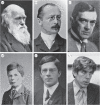The rarer-sex effect
- PMID: 36934750
- PMCID: PMC10024978
- DOI: 10.1098/rstb.2021.0500
The rarer-sex effect
Abstract
The study of sex allocation-that is, the investment of resources into male versus female reproductive effort-yields among the best quantitative evidence for Darwinian adaptation, and has long enjoyed a tight and productive interplay of theoretical and empirical research. The fitness consequences of an individual's sex allocation decisions depend crucially upon the sex allocation behaviour of others and, accordingly, sex allocation is readily conceptualized in terms of an evolutionary game. Here, I investigate the historical development of understanding of a fundamental driver of the evolution of sex allocation-the rarer-sex effect-from its inception in the writing of Charles Darwin in 1871 through to its explicit framing in terms of consanguinity and reproductive value by William D. Hamilton in 1972. I show that step-wise development of theory proceeded through refinements in the conceptualization of the strategy set, the payoff function and the unbeatable strategy. This article is part of the theme issue 'Half a century of evolutionary games: a synthesis of theory, application and future directions'.
Keywords: consanguinity; game theory; reproductive value; sex allocation; sex ratio; unbeatable strategy.
Conflict of interest statement
I declare I have no competing interests.
Figures

Similar articles
-
The early rise and spread of evolutionary game theory: perspectives based on recollections of early workers.Philos Trans R Soc Lond B Biol Sci. 2023 May 8;378(1876):20210493. doi: 10.1098/rstb.2021.0493. Epub 2023 Mar 20. Philos Trans R Soc Lond B Biol Sci. 2023. PMID: 36934759 Free PMC article. Review.
-
Hermaphroditic origins of anisogamy.Philos Trans R Soc Lond B Biol Sci. 2023 May 8;378(1876):20220283. doi: 10.1098/rstb.2022.0283. Epub 2023 Mar 20. Philos Trans R Soc Lond B Biol Sci. 2023. PMID: 36934747 Free PMC article.
-
Stackelberg evolutionary game theory: how to manage evolving systems.Philos Trans R Soc Lond B Biol Sci. 2023 May 8;378(1876):20210495. doi: 10.1098/rstb.2021.0495. Epub 2023 Mar 20. Philos Trans R Soc Lond B Biol Sci. 2023. PMID: 36934755 Free PMC article. Review.
-
Evolutionary game theory and the adaptive dynamics approach: adaptation where individuals interact.Philos Trans R Soc Lond B Biol Sci. 2023 May 8;378(1876):20210502. doi: 10.1098/rstb.2021.0502. Epub 2023 Mar 20. Philos Trans R Soc Lond B Biol Sci. 2023. PMID: 36934752 Free PMC article. Review.
-
Mating behavior and reproductive morphology predict macroevolution of sex allocation in hermaphroditic flatworms.BMC Biol. 2022 Feb 7;20(1):35. doi: 10.1186/s12915-022-01234-1. BMC Biol. 2022. PMID: 35130880 Free PMC article.
Cited by
-
The early rise and spread of evolutionary game theory: perspectives based on recollections of early workers.Philos Trans R Soc Lond B Biol Sci. 2023 May 8;378(1876):20210493. doi: 10.1098/rstb.2021.0493. Epub 2023 Mar 20. Philos Trans R Soc Lond B Biol Sci. 2023. PMID: 36934759 Free PMC article. Review.
-
Evolutionary game theory of continuous traits from a causal perspective.Philos Trans R Soc Lond B Biol Sci. 2023 May 8;378(1876):20210507. doi: 10.1098/rstb.2021.0507. Epub 2023 Mar 20. Philos Trans R Soc Lond B Biol Sci. 2023. PMID: 36934761 Free PMC article.
-
Female-biased birth sex ratio in a female dispersal primate suggests local resource competition.Biol Lett. 2024 May;20(5):20240002. doi: 10.1098/rsbl.2024.0002. Epub 2024 May 1. Biol Lett. 2024. PMID: 38689558 Free PMC article.
-
Adult Sex-Ratio Bias Does Not Lead to Detectable Adaptive Offspring Sex Allocation Via Nest-Site Choice in a Turtle With Temperature-Dependent Sex Determination.Ecol Evol. 2024 Nov 13;14(11):e70543. doi: 10.1002/ece3.70543. eCollection 2024 Nov. Ecol Evol. 2024. PMID: 39539677 Free PMC article.
-
Why the Shaw-Mohler equation works and when it doesn't.Biol Lett. 2024 Feb;20(2):20230499. doi: 10.1098/rsbl.2023.0499. Epub 2024 Feb 28. Biol Lett. 2024. PMID: 38412965 Free PMC article.
References
-
- von Neumann J, Morgenstern O. 1944. Theory of games and economic behavior. Princeton, NJ: Princeton University Press.
-
- Maynard Smith J. 1982. Evolution and the theory of games. Cambridge, UK: Cambridge University Press.
-
- Maynard Smith J, Price GR. 1973. The logic of animal conflict. Nature 246, 15-18. (10.1038/246015a0) - DOI
Publication types
MeSH terms
LinkOut - more resources
Full Text Sources

